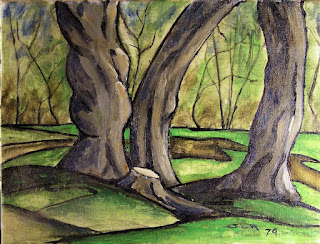 |
| Convent Trees by the Elbow River John Hooker, 1979, 12" X 16" oil on canvas (public domain) |
I would leave the painting on my easel, and just look at it. I would notice things about that I really liked, and the funny thing about that is that I had no awareness of such while I was painting it at all. These things all seemed accidental. For example, in the painting illustrated here, the shape made by the upper part of the space between the two trees on the right took on the aspect of a stained glass window. Appropriate for a painting of convent grounds next to a cathedral. It was not deliberate. I might notice something about a brushstroke, or something about the composition, various different things for each painting (provided I didn't hate it which was far more frequent).
All of my observances had a numinous quality to them, hence "the magic". But I also had the feeling, that before I noticed them, they did not exist. I also had the feeling that if I did not "put the magic in", no one else could notice it either. I did not have any rational explanation for this belief, nor did I feel the need to have one. It was all just part of its "isness".
From the Jungian viewpoint, the "irrational" does not mean crazy, or incapable of analytical thought. It just means intuitive and holistic, "Rational" is just ABC 123, everything in order, law based, and the like. Not very creative at all.
I see this in the best Palaeolithic art, too. We do have the same brains. Of course now we have a lot of data filling our minds, conscious stuff. I wonder which of us has more rules and order and scientific procedures. I wonder which of us had more "magic" instead.
Jung used art to access his patient's unconscious. Are you seriously going to try to tell me that the Palaeolithic artist could not experience the aesthetic and its numinous qualities and that they were all just ancient functionaries of a sort? Obviously you are not an artist if that is the case.
No comments:
Post a Comment